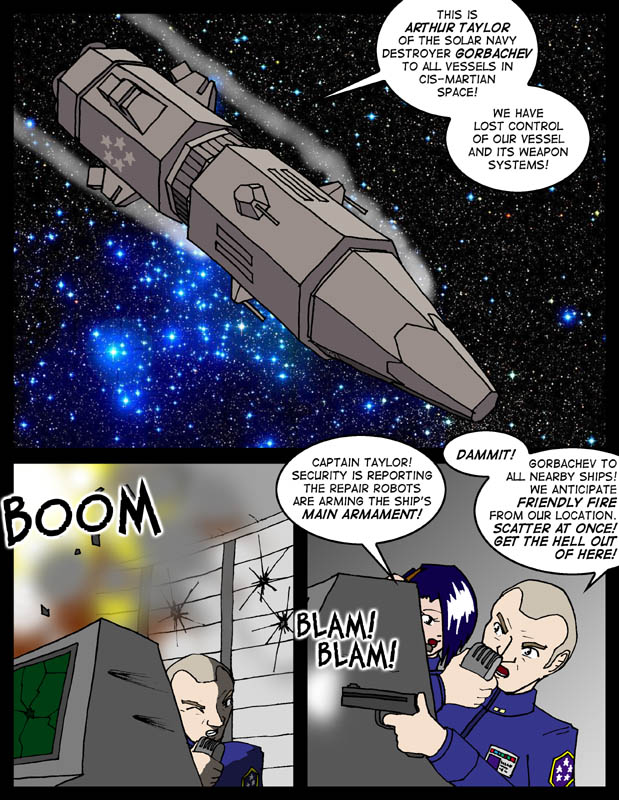
| ||
|
(Jon sez:)  My previous column was really, really, unnecessarily long. Therefore this
one will be short.
My previous column was really, really, unnecessarily long. Therefore this
one will be short.
Note the narrow bit at the center of the Gorbachev. This section rotates to provide weight inside the command-and-control sections of the ship. Unlike the Martians, the rest of civilization in A Miracle of Science doesn't have a way of generating artificial gravity. P.S. I just saw Hayao Miyazaki's Spirited Away. It's a beautiful film. I highly recommend it. |
(Mark sez:)  Designing spaceships is something I obviously enjoy doing, so that's a good excuse to blather about how I did the design work for the Gorbachev.
Designing spaceships is something I obviously enjoy doing, so that's a good excuse to blather about how I did the design work for the Gorbachev.
There are two elements to designing a spaceship for a comic strip. The first is the emotional reaction the ship is supposed to generate in the reader. Despite the minor robot problem Captain Taylor is having, the Solar Navy in A Miracle of Science is nonetheless a competent, professional, and well-funded organization tasked with doing good works. The ship needed to look clean and carefully designed and really not too ominous at all. The model I ultimately started with for the Gorbachev was the U.S. Navy's Arleigh Burke class guided missile cruiser. The second and trickier element is the amount of scientific or technical accuracy (is this spaceship's technology consistent with the tech level in the story?) and general realism (is this design actually practical?) one is going for. Malarkey, where the ships above came from, was set multiple millennia in the future when any random technology could be taken for granted, and furthermore was not a realistic story by any means; thus, I felt free to design the spacecraft purely on a basis of the emotional reactions they were supposed to generate. But MoS, as we well know, strives for absolute scientific accuracy and thus places some interesting constraints on ship design. Although the Arleigh Burke class ships are pretty spiffy-looking, ocean-going warships just don't translate directly into space-going vehicles from a practicality standpoint (beloved '70s anime notwithstanding.) There is, of course, no enforced up or down in space, so in real life the Yamato -- with all its armament on the top deck -- would be hopelessly vulnerable to attacks from underneath. In addition, unless it's delivering a broadside, the Yamato has a hard time focusing all its weaponry on a target, given all the random crap that's in the way. Therefore, a sleek and symmetrical design for the Gorbachev was called for. Guns and missile tubes are located on all sides of the vehicle, and the amount of superstructure obstructing their field of fire is minimal. (Indeed, since the ship is cylindrical, the guns can even usefully traverse below horizontal.) The other constraint -- scientific accuracy -- is demonstrated with the rotating crew section Jon alluded to. In MoS, only the Martians have magic-tech like antigravity; therefore, if there's going to be gravity on the Gorbachev, it will have to be generated by rotating part of the ship and creating centrifugal force. The example you will be familiar with (particularily if you are a nerd) is the Earth Alliance destroyer from Babylon 5. While a snappy-looking ship indeed, it does present the problem that those giant rotating compartments are huge targets -- if someone blasts one of them, the ship will probably go out of balance like a washing machine and fly to pieces. The Gorbachev avoids this issue by having the rotating section be mostly recessed and protected by the rest of the ship. So, there you go. If you've actually read this far and have more questions about art and design in MoS, please feel free to mail us and they will be answered in a future edition of this column. |
|